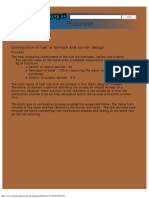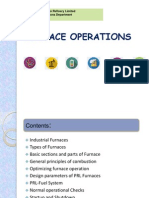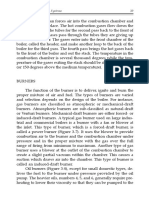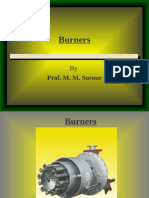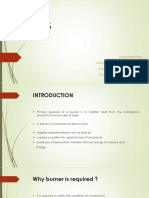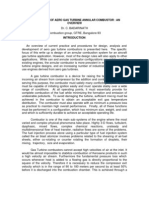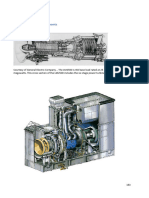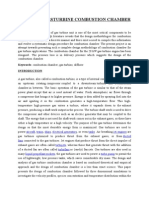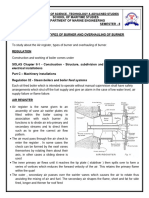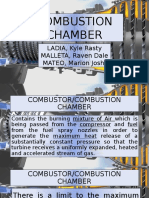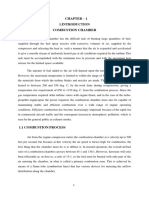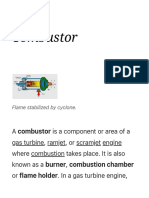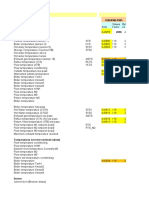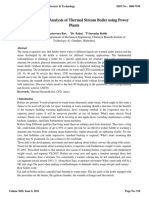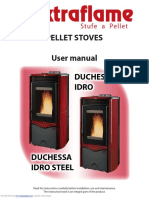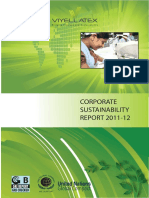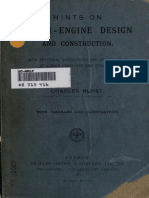3 Gas and Oil Fuels
3 Gas and Oil Fuels
Uploaded by
Cristhian Garcia VillarroelCopyright:
Available Formats
3 Gas and Oil Fuels
3 Gas and Oil Fuels
Uploaded by
Cristhian Garcia VillarroelOriginal Description:
Copyright
Available Formats
Share this document
Did you find this document useful?
Is this content inappropriate?
Copyright:
Available Formats
3 Gas and Oil Fuels
3 Gas and Oil Fuels
Uploaded by
Cristhian Garcia VillarroelCopyright:
Available Formats
3
Gas and Oil Fuels
Gas and Oil Burners for Boilers: General Data; Gas or Oil Burner Check List:
Industrial Quality; Firetube Boilers: Gas and Oil Fired; Waterwall Boilers: Gas
and Oil Fired.
I.
GAS AND OIL BURNERS FOR BOILERS:
GENERAL DATA [53]
The burner is the principal equipment component for the firing of the fuel into
the boiler. Its functions include mixing the fuel and air, atomizing and vaporizing
the fuel, and providing for continuous ignition of the mixture. Significant burner
design characteristics include turndown ratio, stability, and flame shape.
A. Turndown Ratio
The burner turndown ratio is the ratio of the maximum to the minimum fueland-air mixture input rates at which the burner will operate satisfactorily. It specifies the range of fuel mixture input rates within which the burner will operate.
The maximum input rate is limited by flame blowoff and physical size of the
equipment. Flame blowoff is the phenomenon that results when the mixture velocity exceeds the flame velocity. The minimum input rate is limited by flashback
and by the minimum flow rate at which the equipment controlling the mixture
ratio will function. Flashback occurs when the flame velocity exceeds the mixture
velocity.
A high turndown ratio is desirable when a high input is needed during initial
heat-up, but cannot be used during the entire heating cycle. It is unnecessary in
continuously fired boilers, which seldom have to be started cold.
B. Stability
A burner is considered stable if it will maintain ignition when the unit is cold at
normal operating fuel/air ratios and mixture pressures. A burner is not considered
81
82
Chapter 3
stable merely because it is equipped with a pilot. Many burners will not function
satisfactorily under adverse conditions, such as cold surroundings, unless the mixture is rich and the flame is burning in free air. With burners of this type, it is
necessary to leave the furnace door open during the start-up period. Without an
open door, the free air inside the furnace would be quickly used up and the flame
extinguished.
C.
Flame Shape
For a given burner, changes in mixture pressure or amount of primary air will
affect flame shape. In most burners, increasing the mixture pressure will broaden
the flame, whereas increasing the amount of primary air will shorten the flame
(input rate remaining the same).
Burner design affects flame shape to an even greater degree. Good mixing,
resulting from high gas turbulence and velocities, produces a short bushy flame.
Poor mixing and low velocities produce long slender flames. High atomizing air
pressure tends to throw the fuel farther away from the burner nozzle before it
can be heated to its ignition temperature, thereby lengthening the flame.
D.
Atomization
Atomization is necessary to burn fuel oil at the high rates demanded of modern
boiler units. Atomization exposes a large amount of oil particle surface for contact
with the combustion air. This helps assure prompt ignition and rapid combustion.
The two most popular types of atomizers are steam (or air) and mechanical.
The steam (or air) atomizer is the most efficient and most commonly used.
It produces a steam-and-fuel emulsion (or air-and-fuel mixture) which, when released into the furnace, atomizes the oil through the rapid expansion of the steam
(or air). Steam used for atomization must be dry because moisture causes pulsations, which can lead to loss of ignition.
Mechanical atomizers use the pressure of the fuel itself for atomization.
One type of mechanical atomizer is the return-flow atomizer. Fuel flows under
pressure into a chamber from which it issues through an opening in the sprayer
plate as a fine conical mist or spray. Any oil that exceeds the boiler input requirements is returned to the fuel oil system.
Fuel oil must be atomized and vaporized to burn. Fuel oil will not burn as
a liquid. It must first be converted into a gas. Good atomization requires that a
large amount of air be initially mixed with the oil particles. The air must be
turbulent to assure proper mixing. Then heat must be radiated into the spray to
vaporize it.
Burner nozzles are designed for oil of a specific viscosity range, and variation from those viscosities will result in poor atomization. With heavy fuel oils,
correct oil viscosity may be obtained by preheating the oil. Therefore, it is essential to know the viscosity range for which the burner is designed and determine
Gas and Oil Fuels
83
the correct level of preheat needed to maintain the viscosity within this range.
The design atomization viscosity of a burner should be obtained from the manufacturer.
E.
Preheat
If the preheat is too high, the viscosity is lower than recommended and poor,
fluctuating atomization occurs. This causes the flame to be noisy and unstable. If
the preheat is too low, the viscosity is too high. This causes improper atomization,
resulting in droplet size being overly large. These larger droplets are more difficult to vaporize and incomplete combustion and soot formation are more likely
to occur.
II. GAS OR OIL BURNER CHECK LIST:
INDUSTRIAL QUALITY
An industrial quality gas or oil burner should meet the following specifications:
1. Forced draft (FD) fan of industrial quality, mounted on concrete base
or on windbox. If FD fan is mounted on windbox, mounting plate is
to be of 3/8-in. thick (minimum) with stiffeners. It should run at 1800
rpm for less noise and longer life. Direct drive.
2. FD fan airflow controlled by heavy-duty inlet vortex.
3. Windbox depth: sufficient to ensure even air distribution
4. Windbox plate of 1/4-in. thickness, with angle stiffeners.
5. Access door in windbox.
6. Burner turndown: gas 10 : 1; oil 8:1.
7. Industrial quality Fireye Flame scanner (or equal): heavy-duty wiring.
8. Flame safeguard system programmed in solid-state programmable
controller, of a standard heavy industrial type.
9. Indicating lights should be of heavy-duty industrial quality: low-voltage transformer type.
10. Circuit breakers used for electrical circuit protection.
11. Heavy-duty industrial quality relays and timers used where required.
12. Adjustable register for shaping flame to fit furnace configurations.
13. Hinged burner door allowing easy access to examine register parts.
14. Two (2) flame observation ports per register.
15. Cast alloy diffuser.
16. Stainless steel gas jets, preferably removable.
17. Steam-atomizing oil burner. Option to start with plant air.
18. Easily removable oil gun, preferably screw and yoke connector. Tips
to be alloy steel, easy to change.
19. Scavenger pump system to evacuate oil from gun and hose on every
oil shutdown. Pump to be positive-displacement gear pump.
84
Chapter 3
20. NEMA 12-flame safeguard panel.
21. Maxon gas valves: standard.
22. 1-in.diameter (minimum) jackshaft for heavy duty industrial linkage
on single point positioning control systems.
III. FIRETUBE BOILERS: GAS AND OIL FIRED [6,7]
A.
Scotch Marine
1.
Packaged Scotch Marine Boilers
This name applies to horizontal boilers designed around a burner firing either
natural gas and/or fuel oil. The flame, in the shape of a candle flame lying on
its side, is introduced into a corrugated round metal tube (that is surrounded by
water), passes through this tube, hits a rear wall, reverses direction and passes
through boiler tubes (fire tubes) surrounded by water, to a front wall, changes
direction to a vertical flow and passes out the stack. In this arrangement, the stack
is at the front of the boiler. This is a two-pass boiler (Fig. 3.1).
If the hot gases reverse direction at the front wall and pass through firetubes
to the back wall, then up and out the stack, you have a three-pass scotch marine
packaged boiler. In this arrangement, the stack is at the rear of the boiler.
Four-pass scotch marine packaged boilers have been built, but they are
rare. The cost of the fourth pass is just barely justified in the increased heat
transfer surface, and this design is seldom seen. (The main reason seems to be
that this section of the boiler market is very price competitive, and every effort
is made to keep the price of the finished product as low as possible.)
Steaming capacity range
Working pressure limit
Superheat availability
Fuels
Water treatment required
Design types
2.
25040,000 lb/hr
300325 psig (limited by flat heads)
None
Natural gas, no. 2 fuel oil, and rarely no. 6 fuel oil
Basic
Dry-back, two-pass (stack on front)
Dry-back, three-pass (stack on back)
Dry-back, four-pass (rarely seentoo expensive)
Wet-back, two-pass (stack on front)
Wet-back, three-pass (stack on back)
Wet-back, four-pass (very raretoo expensive)
Design Criteria
The scotch marine boiler normally consists of a cylindrical shell, flat heads on
each end, a cylindrical corrugated furnace in the lower section running from the
Gas and Oil Fuels
85
FIGURE 3.1 Combustion gas passage through a scotch marine packaged boiler.
front head to the back head, and one or more tube passes attached to both heads.
The use of flat heads that have to be anchored by staybolts limits the maximum
working pressure to approximately 325 psig maximum. It was developed during
World War II.
Dry-back: This term is used to describe a scotch marine boiler that has
a rear combustion chamber (turn-around section) that is refractory lined.
The rear door is also refractory lined. This is a higher maintenance design
than the wet-back.
86
Chapter 3
Wet-back: This term is used to describe a scotch marine boiler that has
a rear combustion chamber (turn-around section) that is water-jacketed.
The rear door is also designed to be water-jacketed.
Corrugated furnace: This tube is called a Morison tube for the inventor.
It is a straight cylinder that has been run through a special roller that puts
corrugations at regular intervals, completely around the circumference of
the cylinder. This increases strength and heat transfer. The furnace is
not refractory lined.
Combustion gas flow: The gas or oil is burned in a burner setting, attached
to the front of the furnace. Sometimes, the burner refractory throat extends into the very front section of the furnace. On a two-pass unit, the
combustion products proceed through the furnace to the turnaround area
at the back, reverse direction and flow through the one pass of tubes to
the stack breeching on the front of the boiler. On a three-pass unit, the
combustion products make another reversal of direction and flow to the
stack breeching, the stack is on the back of the boiler. The heat transfer
percentage decreases with each pass, that is why a four-pass unit is rarely
seen, the economics just are not there.
Water circulation: Feedwater is introduced to the scotch marine boiler
near the bottom of one side of the cylinder. The water rises between the
tubes, usually faster in the rear than in the front; cooled water courses
downward along the shell, then upward around the furnace to complete
the cycle. The large water surface permits steam release with minimum
foaming.
Water treatment: Precipitates, scale, and silt collect in the space under
the furnace. Blowdown is important. The scotch marine design is well
suited for operation with minimum quality feedwater.
3.
Advantages of the Firetube Boiler Versus
the Waterwall Boiler
1.
2.
3.
4.
5.
Cheaper in price than waterwall boilers of the same capacity and pressure.
Respond to the first load swing faster, because of about 3.5 times more
water at or near the saturation temperature.
Easier installation in low headroom situations.
Low susceptibility to cold-end corrosion. Critical parts of firetube boilers are maintained at or above the saturation temperature throughout
the load range.
Require less feedwater treatment than a waterwall boiler.
Gas and Oil Fuels
TABLE 3.1
87
88
TABLE 3.1 Continued
Chapter 3
Gas and Oil Fuels
TABLE 3.1 Continued
89
90
Chapter 3
4. Disadvantages of the Firetube Boiler Versus
the Waterwall Boiler
1.
2.
3.
4.
5.
6.
7.
8.
Less efficient than the waterwall, thus more expensive to operate.
Does not respond to load swings as fast as a waterwall boiler.
The firetube design is marginal when used to fire solid fuel.
Limited to saturated steam temperature, no superheat.
Limited to low to medium steam pressure.
Firetube design is not practical over 50,000 lb/hr steaming capacity.
Lower steam purity than the waterwall.
Higher CO and nitrogen oxides (NO x ) emissions than a waterwall.
See Table 3.1 for further details.
IV. WATERWALL BOILERS: GAS AND OIL FIRED
A.
Packaged Waterwall Boilers
This boiler design concept is built around the waterwall. This refers to the
tubes connecting the steam drum to the mud drum. The tubes are attached to
each other with a continuous strip of metal (called a membrane), usually this
strip is 3/161/4 in. thick by 1.0 in. wide and whatever length that is required.
This forms a continuous wall of tubes filled with water at the bottom and steam
at the top, thus waterwall. This waterwall design is used in the outerwalls and
also in some cases, the dividing wall between the furnace section and the convection section.
This boiler wall design is very efficient in heat transfer, especially in the
furnace area. The majority of the radiant heat that strikes the membrane bar is
transferred to the tube on either side. This waterwall design also acts as a gastight wall, which also adds to the efficiency of the boiler.
As you know, boiler walls were originally mostly refractory. The problems
were many. The normal furnace temperature is 22002400F when firing natural
gas. It is higher when firing fuel oil. This can reach a maximum temperature of
3200F. This high temperature is very detrimental to refractory. The continuous
operation of the furnace at these high temperatures will, over time, cause the
disintegration of the refractory. Refractory maintenance was a very high dollar
item in the power plant budget.
Waterwalls were added to existing watertube boilers before they were incorporated into the newly designed package units. The waterwalls allowed the
boilers to be operated continuously at the maximum firing rate and still realize
good operating economics. The waterwalls cut down on outages, greatly reduced
or eliminated refractory maintenance, and also permitted the efficient firing of
lower grade fuels.
Gas and Oil Fuels
91
A secondary effect of waterwalls is the lowering of the furnace temperature. Most of this is due to the increased absorption of radiant heat by the waterwall. This lowering of furnace temperature directly affects the formation of
NO x. As the furnace temperature decreases, the formation of combustion NO x
decreases.
FIGURE 3.2 Two types of packaged boilers built with membrane waterwalls.
92
Chapter 3
TABLE 3.2 Fuel Oil Atomization
Steam atomization
1. Best suited to variable load.
2. Wide capacity range without
changing tip or gun assembly.
3. Frequent cleaning of tip unnecessary, as openings are relatively
large and can be quickly blown
out with steam.
4. Capacity up to 120 million Btu
per nozzle per hour.
5. Considerable flexibility for shaping flame to conform with furnace conditions.
6. Relatively low oil temperature required (approximately 185F), as
viscosity need only be low
enough (40 SSU) to readily permit pumping.
7. Oil pressure 2125 psi.
8. Steam for atomization may vary
from 0.7 to 5.0%. The approximate average for careful operation is 1.25%.
9. Steam for atomization is lost up
the stack, and must be considered when there is a question of
makeup water.
10. Lower air pressure required, because aspirating effect of the
steam jets makes up for some of
the pressure drop in the register.
11. Lower fixed charges, because of
lower temperature and furnace
requirements.
Source: Ref. 15.
Mechanical atomization
1. Best suited to steady load and
high capacity.
2. Limited capacity range for any
given tip size; wide-range system overcomes this somewhat.
3. Frequent cleaning of tip necessary to maintain efficient spray.
Owing to relatively small opening, entire gun assembly must
be removed so sprayer plate and
tip orifices may be carefully
cleaned.
4. Capacity up to 100 million Btu
per nozzle per hour.
5. No flexibility in flame shape.
6. Relatively high oil temperature required (approximately 220F), as
viscosity must be low enough
(180220 SSU) to produce satisfactory atomization.
7. Oil pressure 50250 psi.
8. Steam for pumping and heating
varies from 0.5 to 1.0%, and is
governed by the equipment installed, rather than by operation.
9. Exhaust steam from pump and
heater set may be returned to
hotwell, thereby minimizing
makeup.
10. Higher air pressure required, because of the absence of aspirating effect with the mechanically
produced spray.
11. Fixed charges high, owing to
cost of equipment to provide for
high-pressure and high-temperature requirements.
Gas and Oil Fuels
TABLE 3.3
93
94
TABLE 3.4
Chapter 3
Gas and Oil Fuels
TABLE 3.5
95
96
TABLE 3.6
Chapter 3
Gas and Oil Fuels
TABLE 3.7
97
98
TABLE 3.8
Chapter 3
Gas and Oil Fuels
99
TABLE 3.9
As the prices of natural gas and fuel oil slowly edge upwards, the efficient
operation of a boiler becomes more and more important. This leads to the following considerations in packaged boiler design.
1. All boiler outer walls are to be of the membraned waterwall design.
2. All outer tube walls are to be connected by membrane with no corner
joints.
100
Chapter 3
3.
4.
5.
The complete packaged membrane waterwall boiler to be 100% gas
tight.
The dividing wall between the furnace and convection sections is to
be a gas-tight membrane waterwall.
A refractory is to be used only to protect the steam drum and mud
drum from flame impingement and thus disruptive heat transfer affecting water circulation.
When a boiler manufacturer follows these design parameters, a highly efficient, compact boiler can be shop-assembled and shipped. Size is limited only
by rail or road clearance. If shipment by water is available to the plant, then the
size limit to a packaged waterwall boiler seems to be about 350,000 lb of steam
per hour. Packaged waterwall boilers of over 3000 psig operating pressure have
been built and are in operation. Steam temperature up to 1000F is standard
design.
A large packaged boiler, say 150,000 lb of steam per hour with steam at
650 psig and 710F, built to the foregoing parameters, operating at capacity
around the clock, using the best controls, using the best low NO x burner, burning
natural gas, will operate with an efficiency of 84.085.0%.
Figure 3.2 shows for two typical packaged waterwall boiler designs. Tables
3.23.9 give fuel oil atomization, oil and gas analysis, combustion constants,
minimum autoignition temperatures, and natural gas and fuel oil examples and
formulas.
You might also like
- Burners: Air-Steam Atomizing Oil BurnersDocument8 pagesBurners: Air-Steam Atomizing Oil BurnersAhmed GadNo ratings yet
- Boiler BurnersDocument8 pagesBoiler BurnersAnoop VijayakumarNo ratings yet
- Boiler ComponentsDocument40 pagesBoiler ComponentsaloordominicNo ratings yet
- Eit-M: Thermal Power PlantDocument13 pagesEit-M: Thermal Power PlanthayelomNo ratings yet
- Chapter 5 - CombustionDocument5 pagesChapter 5 - CombustionAparna RNo ratings yet
- Boiler BurnerDocument30 pagesBoiler BurnerAbdallah MansourNo ratings yet
- BurnerDocument4 pagesBurnerAhmed Mohamed KhalilNo ratings yet
- Boiler Fuel Firing SystemDocument44 pagesBoiler Fuel Firing Systemrashm006ranjanNo ratings yet
- Economizer, Furnace, Burner, Air Fuel RatioDocument11 pagesEconomizer, Furnace, Burner, Air Fuel RatioPriyaNo ratings yet
- Research Work Week 12Document4 pagesResearch Work Week 12jonas lintagNo ratings yet
- Furnace OperationsDocument53 pagesFurnace OperationsRana Shahid Raza100% (3)
- 1 PDFDocument2 pages1 PDFrohitNo ratings yet
- Burn BodyDocument32 pagesBurn BodyMahmoud Ahmed Ali AbdelrazikNo ratings yet
- Air Breathing Propulsion Unit-2Document54 pagesAir Breathing Propulsion Unit-2api-271354682No ratings yet
- Vacuum Distillation in Petroleum RefiningDocument3 pagesVacuum Distillation in Petroleum RefiningUsama Malik100% (1)
- ch2.2 (burners)Document85 pagesch2.2 (burners)ahmed.sama1992No ratings yet
- Kinemax Gas or Oil Burners: Bulletin 4200Document26 pagesKinemax Gas or Oil Burners: Bulletin 4200agua1829No ratings yet
- Gas Turbine Combustion Chamber Design Aspects & Current TrendsDocument24 pagesGas Turbine Combustion Chamber Design Aspects & Current TrendsPRAVEENNo ratings yet
- 04 Combustion of Fuel in IC EngineDocument40 pages04 Combustion of Fuel in IC EngineVijay RaghavanNo ratings yet
- Design Optimization of Can Type Combustor: T J Prasanna Kumar, S Koteswara Rao, S Durga Prasad, MD Faisal, P AnilDocument8 pagesDesign Optimization of Can Type Combustor: T J Prasanna Kumar, S Koteswara Rao, S Durga Prasad, MD Faisal, P AnilSakuNo ratings yet
- ME-52023 Internal Combustion Engines: Technological University (Hmawbi) Department of Mechanical EngineeringDocument25 pagesME-52023 Internal Combustion Engines: Technological University (Hmawbi) Department of Mechanical EngineeringSi Thu Aung100% (1)
- Research Work Week 11Document2 pagesResearch Work Week 11jonas lintagNo ratings yet
- Burners PDFDocument26 pagesBurners PDFJaymin PatelNo ratings yet
- Fallsem2016-17 2134 RM001 09-Aug-2016 Che2006 THDocument35 pagesFallsem2016-17 2134 RM001 09-Aug-2016 Che2006 THsinsnigNo ratings yet
- Fired Heater Presentation - Final97 2003Document40 pagesFired Heater Presentation - Final97 2003Altif Abood100% (4)
- Development of Aero Gas Turbine Annular CombustorDocument14 pagesDevelopment of Aero Gas Turbine Annular CombustorSurya NarayananNo ratings yet
- Better Burner Specifications PDFDocument4 pagesBetter Burner Specifications PDFAbdul HayyeNo ratings yet
- VacuumDocument7 pagesVacuumMassimilianø Erricø100% (2)
- Managing The Operation of Propulsion Plant Machinery CDocument109 pagesManaging The Operation of Propulsion Plant Machinery CPanagiwtis M.No ratings yet
- Duo FlexDocument8 pagesDuo FlexIsaac Martínez AlcocerNo ratings yet
- Combustion SectionDocument26 pagesCombustion SectionNicole Deione Morcilla100% (1)
- Design of Gas Turbine Combustion ChamberDocument11 pagesDesign of Gas Turbine Combustion ChamberSai Rahul100% (1)
- C CC CC: CCCCCCCCCCCCCCCCDocument27 pagesC CC CC: CCCCCCCCCCCCCCCCMuhammadTanzeeLUsmanNo ratings yet
- Experiment No.: Title-Combustion Chambers in S. I. & C. I. EnginesDocument10 pagesExperiment No.: Title-Combustion Chambers in S. I. & C. I. EnginesAshutosh KumarNo ratings yet
- Air Register, Types of Burner and Overhauling of BurnerDocument4 pagesAir Register, Types of Burner and Overhauling of BurnerSid ACHARYANo ratings yet
- Combustion Chamber DesignDocument19 pagesCombustion Chamber DesignPRAVEEN100% (1)
- Combustion Chamber: LADIA, Kyle Rasty MALLETA, Raven Dale MATEO, Marion JoshDocument28 pagesCombustion Chamber: LADIA, Kyle Rasty MALLETA, Raven Dale MATEO, Marion JoshJames SelibioNo ratings yet
- Co HenDocument40 pagesCo HenHiltonNo ratings yet
- GTE Combustion ChamberDocument33 pagesGTE Combustion ChamberTAMILSELVAM NALLUSAMYNo ratings yet
- Combustion Chamber 1Document22 pagesCombustion Chamber 1MD MUSTAFANo ratings yet
- 03 Combustion ChamberDocument13 pages03 Combustion ChambernareshNo ratings yet
- Combustion Chamber: Aircraft Engines LLDocument6 pagesCombustion Chamber: Aircraft Engines LLSouhaib K Al-AzzawiNo ratings yet
- Combustion Chamber: Aircraft Engines LLDocument6 pagesCombustion Chamber: Aircraft Engines LLSouhaib K Al-AzzawiNo ratings yet
- 1 Description of ICE-finalDocument12 pages1 Description of ICE-finalaliNo ratings yet
- Boiler Module VDocument23 pagesBoiler Module VdeepanckNo ratings yet
- Combustion Chamber ProjectDocument42 pagesCombustion Chamber Project26 MaheshkannanNo ratings yet
- Flame Safeguard Controls in Multi-Burner EnvironmentsDocument33 pagesFlame Safeguard Controls in Multi-Burner EnvironmentsManish KumarNo ratings yet
- Combustor: Flame Stabilized by CycloneDocument56 pagesCombustor: Flame Stabilized by CycloneChadwickajiNo ratings yet
- New 5 LectureDocument28 pagesNew 5 LectureMekonnen AyalNo ratings yet
- Furnace Design and Operation: Fuel Handling SystemsDocument45 pagesFurnace Design and Operation: Fuel Handling SystemskINGNo ratings yet
- Duo FlexDocument8 pagesDuo Flexdwindra ramadhan100% (1)
- Pipe Burner FaqDocument6 pagesPipe Burner FaqdyravanzellaNo ratings yet
- Gun Burner. Materi 1Document10 pagesGun Burner. Materi 1DwiIndraswari100% (1)
- Fundamentals of Combustions and Combustion EquipmentDocument18 pagesFundamentals of Combustions and Combustion EquipmentEngr Mujahid MehdiNo ratings yet
- Module 5 CombustorDocument11 pagesModule 5 CombustorKevin MangroliyaNo ratings yet
- Optimize Fired Heater Operations To Save MoneyDocument8 pagesOptimize Fired Heater Operations To Save Moneyyogitadoda100% (2)
- Installation and Operation Instructions For Custom Mark III CP Series Oil Fired UnitFrom EverandInstallation and Operation Instructions For Custom Mark III CP Series Oil Fired UnitNo ratings yet
- Comparison of Diesel and Petrol EnginesFrom EverandComparison of Diesel and Petrol EnginesRating: 2.5 out of 5 stars2.5/5 (3)
- Gp-Pro/Pb PLC Connection ManualDocument24 pagesGp-Pro/Pb PLC Connection ManualCristhian Garcia VillarroelNo ratings yet
- Vibscanner Short GDocument8 pagesVibscanner Short GCristhian Garcia VillarroelNo ratings yet
- Experience: Design Notes Boiler Operation and Maintenance ExperienceDocument28 pagesExperience: Design Notes Boiler Operation and Maintenance ExperienceCristhian Garcia Villarroel100% (1)
- 5 Steam Boiler FeedwaterDocument16 pages5 Steam Boiler FeedwaterCristhian Garcia Villarroel100% (1)
- Vibscanner FFT GDocument80 pagesVibscanner FFT GCristhian Garcia Villarroel100% (1)
- 6 Boiler Feedwater PumpsDocument20 pages6 Boiler Feedwater PumpsCristhian Garcia VillarroelNo ratings yet
- How To Set Up Reports in The Page LayoutDocument2 pagesHow To Set Up Reports in The Page LayoutCristhian Garcia VillarroelNo ratings yet
- 10 Electricity Generation and CogenerationDocument34 pages10 Electricity Generation and CogenerationCristhian Garcia VillarroelNo ratings yet
- Appendix: I. Conversion Factors (32) A. Heat, Work, and PowerDocument20 pagesAppendix: I. Conversion Factors (32) A. Heat, Work, and PowerCristhian Garcia VillarroelNo ratings yet
- Preface V Requirements of A Perfect Steam Boiler Ix Tables and Spreadsheets XiDocument2 pagesPreface V Requirements of A Perfect Steam Boiler Ix Tables and Spreadsheets XiCristhian Garcia VillarroelNo ratings yet
- Conmutador Y Rebote de ContactosDocument6 pagesConmutador Y Rebote de ContactosCristhian Garcia VillarroelNo ratings yet
- Requirements of A Perfect Steam BoilerDocument2 pagesRequirements of A Perfect Steam BoilerCristhian Garcia VillarroelNo ratings yet
- Voila! - Unlock Protected Blocks in Siemens SIMATIC Step 7Document8 pagesVoila! - Unlock Protected Blocks in Siemens SIMATIC Step 7Cristhian Garcia VillarroelNo ratings yet
- Programación Mediante Registros Pin PORTB1 y PORTB0 Configurados Como Salidas. Se Setean DDB0 y DDB1Document4 pagesProgramación Mediante Registros Pin PORTB1 y PORTB0 Configurados Como Salidas. Se Setean DDB0 y DDB1Cristhian Garcia VillarroelNo ratings yet
- Design of Waste Heat BoilerDocument64 pagesDesign of Waste Heat BoilertelldivyaNo ratings yet
- 1 s2.0 S0360544222017443 MainDocument14 pages1 s2.0 S0360544222017443 MainVignesh AlagesanNo ratings yet
- Chemical Quick Guide PDFDocument1 pageChemical Quick Guide PDFAndrejs ZundaNo ratings yet
- Unique Online Leak Repair TechniquesDocument8 pagesUnique Online Leak Repair TechniquesMario Alfredo MunafóNo ratings yet
- Vitotronic Data Points: V200KW2/KW1Document11 pagesVitotronic Data Points: V200KW2/KW1Cyril PerezNo ratings yet
- Examination and Analysis of Thermal Stream Boiler Using Power PlantsDocument7 pagesExamination and Analysis of Thermal Stream Boiler Using Power PlantsADVOKASI PPI MALAYSIANo ratings yet
- Luxor s0232 GBDocument48 pagesLuxor s0232 GBGabetsos KaraflidisNo ratings yet
- Performance HRSGDocument7 pagesPerformance HRSGalfnusi173100% (2)
- Duchessa IdroDocument48 pagesDuchessa IdroLuncan RaduNo ratings yet
- Thermal Oxidation Solutions - BrochureDocument16 pagesThermal Oxidation Solutions - BrochureMohammed AlShammasiNo ratings yet
- Amsco Evolution - Data SheetDocument8 pagesAmsco Evolution - Data SheetTiến NguyễnNo ratings yet
- Energy EngineeringDocument2 pagesEnergy EngineeringPrashanth JagadeeshNo ratings yet
- Boiler Design Dossier PDFDocument118 pagesBoiler Design Dossier PDFPrashant PandeyNo ratings yet
- Stress Corrosion Cracking in Refunery Pipework and VesselsDocument34 pagesStress Corrosion Cracking in Refunery Pipework and VesselsBOB100% (3)
- Boiler Power Plant PDFDocument91 pagesBoiler Power Plant PDFRejaul Ansary100% (2)
- Congruent Boiler Water ControlDocument3 pagesCongruent Boiler Water ControlprakashNo ratings yet
- Iron Faster With 2 X More Steam : No Temperature Setting RequiredDocument3 pagesIron Faster With 2 X More Steam : No Temperature Setting RequiredReviewuriNo ratings yet
- Sustainability Report 2011-12Document52 pagesSustainability Report 2011-12Jewel RanaNo ratings yet
- PG Test of BTGDocument7 pagesPG Test of BTGO&E CeplNo ratings yet
- Ques - Eee MTDocument12 pagesQues - Eee MTKumaran PalaniNo ratings yet
- Hints On Steam-Engine Design and Construction 1901 PDFDocument64 pagesHints On Steam-Engine Design and Construction 1901 PDFMario Eduardo Santos Martins100% (2)
- Hammer - PPTX Version 1Document110 pagesHammer - PPTX Version 1AjayBravo50% (2)
- Steam GenaratorDocument119 pagesSteam GenaratorRavi balanNo ratings yet
- Steam Power Cycles Part 2Document11 pagesSteam Power Cycles Part 2Saad MubeenNo ratings yet
- BME Lab ManualsDocument50 pagesBME Lab ManualsYash PatelNo ratings yet
- HRSG CorrosionDocument8 pagesHRSG Corrosion5531271467% (3)
- Npti PublicationDocument3 pagesNpti PublicationpapudasNo ratings yet
- Turbine ManualDocument399 pagesTurbine ManualSandeep Kumar100% (3)
- Dictionary of Boiler TerminologyDocument27 pagesDictionary of Boiler TerminologyAlka Seltzer100% (34)


